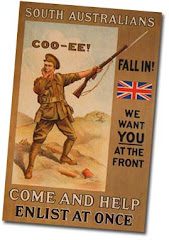 Horace Hilton was a son of Joseph Woodrow Hilton and Eliza Hilton (nee Dix) who married in Clarendon in 1877. The following year, Joseph became the lighthouse keeper at Point Lowly in the north part of Spencer Gulf near Whyalla, but Horace was born in Clarendon in 1893, probably because Eliza would have spent the last part of her pregnancy with her parents or parents-in-law rather than at an isolated lighthouse keepers cottage.
Horace Hilton was a son of Joseph Woodrow Hilton and Eliza Hilton (nee Dix) who married in Clarendon in 1877. The following year, Joseph became the lighthouse keeper at Point Lowly in the north part of Spencer Gulf near Whyalla, but Horace was born in Clarendon in 1893, probably because Eliza would have spent the last part of her pregnancy with her parents or parents-in-law rather than at an isolated lighthouse keepers cottage.Horace had only been a mounted constable for four months when he enlisted in the AIF on 1 November 1915, by which time his father had retired and his parents had moved to Blackwood from their last post at Cape Banks near Carpenters Rocks in the south east of SA. He was allotted to the 14th reinforcements to the 9th Light Horse Regiment, which sailed from Adelaide on 10 February 1916 on the Warilda.
The Warilda arrived in Egypt in March 1916, and Horace found himself re-allocated to the artillery, joining 15th Field Artillery Brigade (5th Australian Division) in April. In June they sailed to Marseilles, then entrained for Le Havre on the Channel coast when the brigade first went into action.
In February 1917, Horace was transferred to 12th (Army) Artillery Brigade when the 15th Field Artillery Brigade was disbanded, and served with it as a member of 112th Howitzer Battery. On 21 March 1918, during the height of the German Spring Offensive, Horace's battery was heavily shelled, and he was wounded in the right arm.
He returned to duty on 11 July 1918, and his battery continued to support the allied offensives that ended the war. Following the end of the war he was employed as an artillery wagon driver. He left Australia to return to Australia in May 1919 and he must have returned to the south-east of the state, as the Advertiser records that he was welcomed home in Mount Gambier on 18 July 1919. He was discharged the following month.
After the war, Horace married Effie Florence. Horace and Effie must have lived in Myponga for some time, as they are both buried in the Myponga Uniting Church cemetery. Horace died in 1962, aged 62, and Effie in 1980 aged 89. Horace's name is inscribed on the Blackwood Memorial.
Photograph courtesy of the Australian War Memorial (E02796) shows Horace (centre, facing camera holding artillery shell) on 31 July 1918. The photographer is unknown, but Captain CEW Bean, the official historian, visited the battery that day.







No comments:
Post a Comment